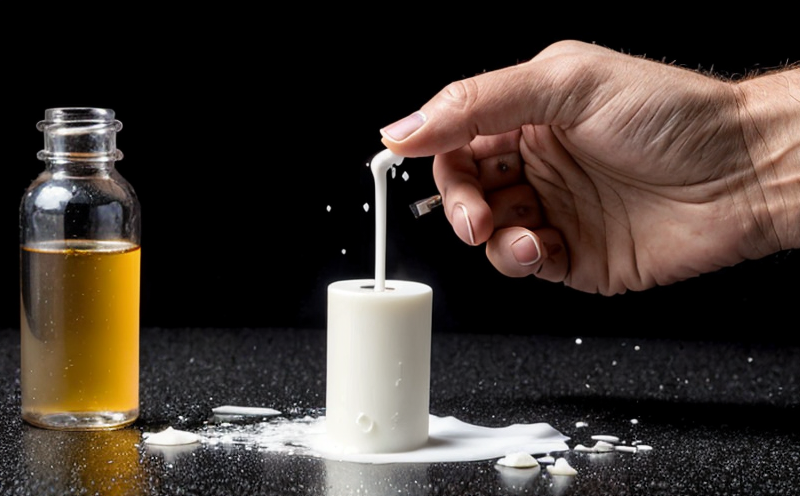USP Disintegration of Lozenges Testing
The USP (United States Pharmacopeia) disintegration test is a critical procedure used in pharmaceutical testing to ensure that drug products meet the required standards for dissolution and disintegration. This process involves examining the physical breakdown of a dosage form under controlled conditions, focusing on the specific case of lozenges.
Disintegration testing ensures that the active ingredients within the product are released as intended in a timely manner when consumed. This is especially important for products like lozenges which have a delicate structure and require precise control over their dissolution rate to ensure effective drug delivery. The USP provides specific guidelines on how this test should be conducted, ensuring consistency and reliability across different laboratories.
The testing procedure involves placing the lozenge in a container filled with a specified volume of water at a controlled temperature (typically 37°C). The container is then agitated to simulate the conditions inside the human body. Over time, the lozenge must break down into smaller pieces until no more than a certain amount remains unbroken after a set period. For lozenges, this time frame is generally between 15 and 60 minutes depending on their formulation.
The USP guidelines are designed to standardize this process so that all laboratories conducting the test follow the same procedures. This helps ensure that results are comparable and reliable across different facilities. The testing apparatus used for this procedure includes a disintegration tester, which consists of a container with an agitator mechanism capable of maintaining consistent agitation throughout the testing period.
During the test, it’s crucial to monitor both temperature and time precisely according to USP specifications. Any deviation from these parameters could lead to inaccurate results, potentially affecting patient safety or regulatory compliance. Proper specimen preparation is also key; ensuring each lozenge used in the test represents an accurate sample of the product being evaluated helps maintain consistency between tests.
The outcome of this testing provides valuable insights into the quality control aspects of pharmaceutical manufacturing processes. It allows manufacturers to identify potential issues early on, making necessary adjustments before products reach the market. Additionally, regulatory bodies rely heavily on such data when assessing whether a particular drug product meets established safety and efficacy criteria.
Understanding the nuances behind USP disintegration testing for lozenges is essential not only for manufacturers but also for those involved in quality assurance processes within pharmaceutical companies. By adhering strictly to these standards, laboratories can ensure accurate assessments of their products' performance during dissolution.
Applied Standards
The primary standard applied in USP disintegration testing for lozenges is the United States Pharmacopeia (USP) Chapter 711 - Disintegration of Oral Dosage Forms. This chapter provides detailed instructions on how to conduct this type of test, including specific requirements for apparatus, sample preparation, and observation times. Compliance with these standards is mandatory for any laboratory performing such tests.
- USP 711 - Disintegration of Oral Dosage Forms: This standard outlines the general principles applicable to all oral dosage forms tested through disintegration methods.
- USP Dissolution Test Methodology: While not directly related to disintegration, this section is often referenced alongside as part of a broader quality assurance framework for ensuring drug product integrity.
Customer Impact and Satisfaction
The results from USP disintegration testing play a crucial role in enhancing customer confidence by demonstrating that the products meet strict regulatory requirements. For quality managers, compliance officers, R&D engineers, and procurement professionals involved in pharmaceutical development and production, ensuring adherence to these tests helps maintain high standards of product integrity.
For customers purchasing medications or dietary supplements, knowing that manufacturers follow rigorous testing procedures like USP disintegration ensures they receive reliable products. This contributes significantly to overall customer satisfaction as it reduces concerns about product efficacy and safety.
In addition to improving reputations among consumers, successful completion of these tests can lead to favorable reviews from regulatory bodies such as the FDA (Food and Drug Administration). Such endorsements further enhance a company’s standing within the industry, fostering trust not only with end users but also with stakeholders like investors and business partners.
Use Cases and Application Examples
- New Product Development: During the early stages of drug development, USP disintegration tests help researchers optimize formulations to achieve optimal dissolution rates while maintaining product stability.
- Quality Assurance: Regularly performing these tests ensures ongoing compliance with regulatory standards and helps identify any potential issues in the manufacturing process that could affect product quality.
- Compliance Audits: When faced with audits by regulatory authorities, having accurate documentation of USP disintegration test results can provide assurance regarding a company’s commitment to maintaining high-quality standards.
- Market Expansion: Demonstrating compliance with international standards like the USP can open doors for expansion into new markets where strict regulatory requirements apply.
- Customer Feedback: Positive results from USP disintegration tests can be shared with customers to build trust and demonstrate a commitment to delivering high-quality products.





